Managing Stormwater in Impervious Environments
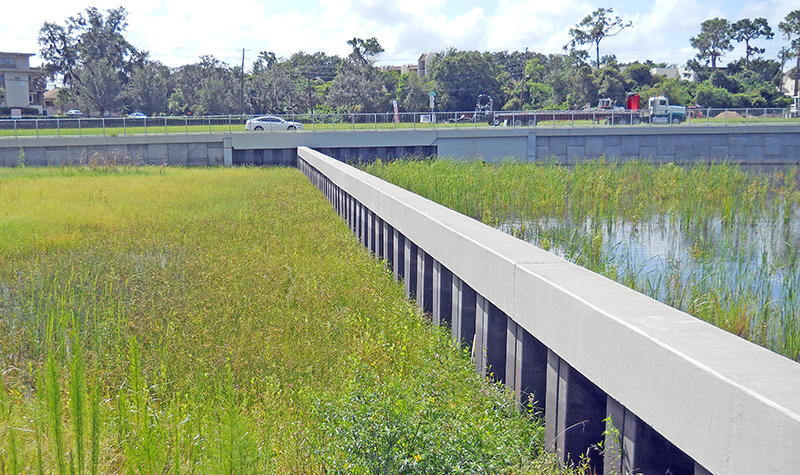 By Craig Schuh, PE
By Craig Schuh, PE
Water that collects after a rain or snowmelt must go somewhere. It may pool and eventually evaporate and/or seep into the ground. It may follow the contour of the land and run into a stream or ditch. In either case, vegetation slows the water’s flow, promotes infiltration, and helps filter out contaminants before the water runs into a stream or other stormwater collection point.

About the Expert:
Craig Schuh, PE, joined Ayres in 1999 and has risen to the position of manager of municipal engineering. As a municipal engineer, he is responsible for managing and designing municipal and site civil projects, assisting transportation engineers with stormwater design, and guiding final design documents to completion.
Construct a building, parking lot, or roadway on vacant land, and those impervious surfaces change the natural flow of water through the site. The subsequent runoff may carry debris, sediment, and potentially harmful substances into waterways and can cause erosion and exacerbate localized flooding.
Civil engineers, urban planners, designers, and environmental professionals use several tools to mitigate the effects of that lost land surface. Detention basins temporarily store water during a rain or flood event, allowing for the settling of pollutants and sediment. They are likely the most common approach to stormwater management. Roofs may support green roofs to slow and reduce water flow. Parking lots and roadways may include buffer areas (bioswales) or bioretention areas with native plants to slow flows and help remove potentially harmful particulates. Permeable pavement may be used in parking lots, pedestrian areas, and roadways to allow for groundwater to seep through them and into the ground.
Detention Basins
Detention basins temporarily store runoff during rain or flood events. They are designed in two forms: dry or wet. A dry detention basin imitates the conditions of naturally vegetated areas by allowing sediment to settle out of the stormwater runoff; stormwater slowly drains at a controlled rate until the basin empties. A wet detention basin is preferred to its counterpart. They are wet year-round and hold a permanent pool of water. The wet detention basin acts as a water treatment device by having a prolonged time to hold water, ranging from many days to several weeks. This allows numerous pollutant removal mechanisms to operate, most notably settling. Detention basins are economical methods to effectively control peak runoff flows, and provide treatment, if the required land is available.
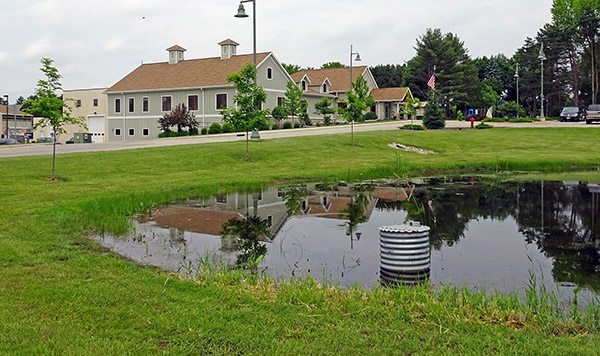
Underground Detention Systems
Underground detention systems function very similarly to conventional open basins, but they are subsurface and allow for pavements overtop. They are typically constructed of storm sewer pipes or plastic or concrete chambers, with open graded stone and outflow control weirs or structures. The underground systems can control peak runoff flows and remove pollutants depending on the regulatory needs. Underground systems are generally more expensive than open detention basins but are well suited for stormwater management where real estate is at a premium. Manufacturers are offering increasingly more options, making the technology more economical.
Bioretention
What is Bioretention?
Bioretention uses highly engineered, living structures to clean runoff while transporting it to a waterway or other stormwater component. Engineered soil filters pollutants and sediment and promotes infiltration.
Bioretention areas are designed to maximize the time from when runoff leaves a parking lot or roadway to when it filters into the ground or flows into a waterway or other stormwater collection area. The more time, the more opportunity for debris and pollutants to filter out of the water.
What do Bioretention Areas Look Like?
They have gently sloped sides and plants that help curb erosion, slow the progress of runoff, and capture pollutants – often while providing visual appeal and habitat for birds and other animals.
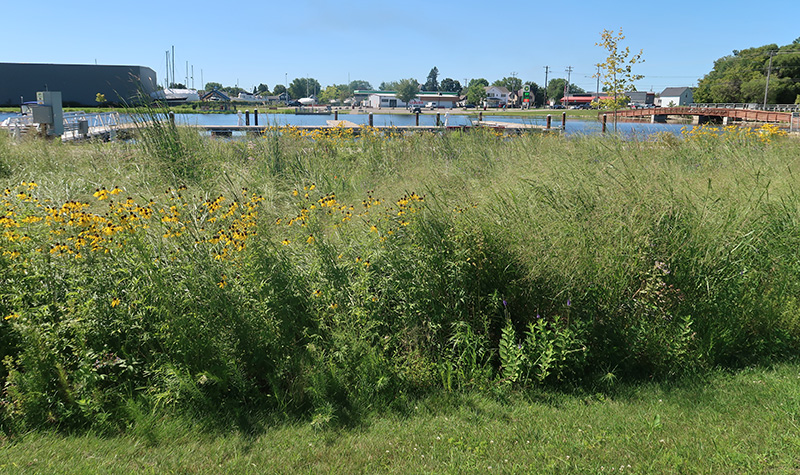
The vegetation may be as simple as low growing grasses – though turf lawn is not allowed in some states – or as complex as a miniature ecosystem that mirrors the local landscape, with taller growing plants, ornamentals, shrubs, and trees. Native deep root plants are preferred, as they will be naturally hardy to the region and should require less maintenance. Turf lawn is not allowed in Wisconsin, where native plantings must be used. The plantings can include grasses, but they’re not to be mowed and must have very deep root systems. These deep-rooted plants uptake nutrients and remove it from the stormwater.
Some bioretention areas also include rock sections to minimize erosion, and act as level spreaders to reduce energy from point discharges into the area.
How Does a Bioretention area “Clean” Runoff?
- Sediment has a chance to drop to the bottom, reducing turbidity.
- Runoff is filtered as it infiltrates into the engineered soil.
- Many organic compounds degrade over time; bioretention areas slow the flow of these materials into waterways.
- Pathogens are deprived of a nutrient supply long enough for them to become the target of microorganisms.
- Inorganic compounds and nutrients such as phosphates and nitrates are absorbed and taken up by specific plants.
Green Roofs
What is a Green Roof?
A green roof, also known as a vegetative or eco-roof, consists of a layer of growing medium and vegetation placed on a roof over several specific layers that foster growth and protect the structure underneath.
Categories of Green Roofs:
- Extensive: Consists of a shallow layer of growing medium, typically less than six inches, with low plant diversity, and similarly low water needs. (Lightest of the three categories.)
- Semi-intensive: Blending between extensive and intensive, this category uses more growing medium, features more plant diversity – and potentially more maintenance – than the extensive category.
- Intensive: Features much deeper growing medium, sometimes several feet, and can accommodate a range of vegetation, including small trees. This category requires the most maintenance and watering. (Heaviest of the three categories.)
To limit the load on the structure beneath, and promote water retention, green roofs do not use standard soil. Instead, a mineral aggregate mix is used.
Benefits of a Green Roof?
Though they present a higher upfront cost than a traditional roof, green roofs provide a range of benefits to both the structure beneath and the surrounding community. A few potential benefits are listed below, but the list goes on including extending roof life and reducing greenhouse emissions.
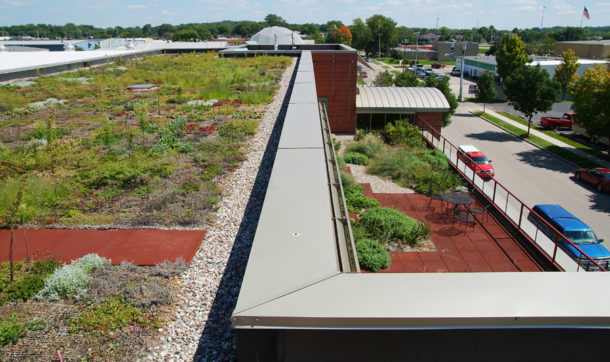
Stormwater Management: As mentioned above, impervious surfaces, from buildings to parking lots, change the natural flow of water and place an increased load on stormwater infrastructure. Green roofs help by slowing and reducing stormwater by retaining it in the plants and growing medium. And much like bioretention areas below, the plants and growing medium can act as a filter “cleaning” the water as it passes through.
Urban Heat Island Effect: Large amounts of paved surfaces absorb solar radiation and re-radiate it as heat. This leads to cities having higher temperatures than the rural areas that surround them, which is known as the Urban Heat Island Effect. Green roofs absorb less heat than a traditional dark roof and additionally some of that heat is used to evaporate the retained water.
Energy Efficiency: Green roofs decrease the overall temperature of the roof by absorbing less heat. They also serve as a layer of insulation, decreasing the amount of heat being passed into the building, in turn making it simpler to cool the building beneath. That lower level of reflective heat on the roof also improves the efficiency of roof-based mechanical equipment, which can also help to lower energy expenditure during the cooling months.
Permeable Pavement
As its name suggests, permeable pavement – also called pervious paving – is a porous urban surface that allows runoff and rainfall to infiltrate through the surface to the soil, or stone reservoir, below. This solution can provide many benefits:
- Water drains into the soil, reducing the impact to stormwater management systems.
- They can be used in developed areas that have little or no room for other means of handling excess water.
- The infiltration process provides a chance for some pollutants to be removed before rainfall or snowmelt enters surface or groundwaters.
That said, the use of permeable pavement can also present challenges:
- Surfaces may require some maintenance, as grit can block the open pores. Vacuuming helps maintain surface permeability.
- In cold regions, materials must be designed to accommodate the freeze-thaw cycle.
- Permeable pavement may not be appropriate in areas of extreme slope.
- Grass pavers will require occasional reseeding. Some people may object to the look of the pavers when the grass is dormant or sparse.
- Permeable pavement presents a higher upfront cost than traditional asphaltic paving.
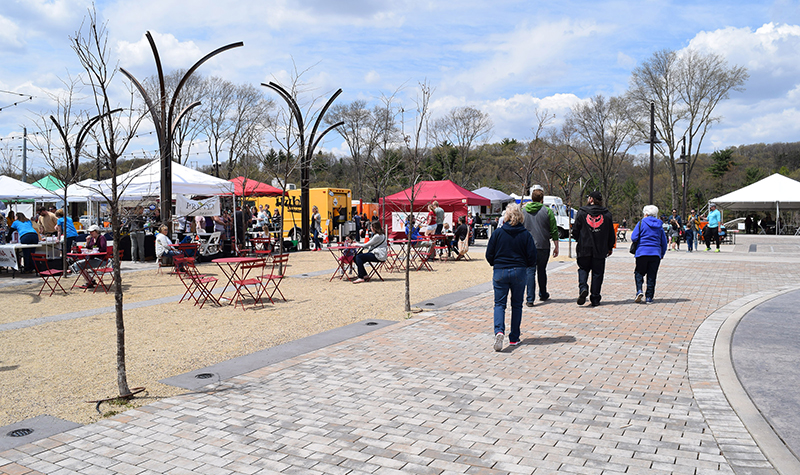
Some Types of Permeable Pavement
- Permeable Asphalt: Produced much like conventional asphalt concrete, except that small aggregates are not included in the mixture. Permeable asphalt has open voids that allow water to pass through the surface. Some projects using permeable asphalt will have a subsurface reservoir to hold the water that passes through the surface. Other projects will use a form of permeable asphalt that allows water to infiltrate only the top inch or so of the pavement; the water is then drained to the side of the roadway
- Permeable Paver Systems: Use standard pavers with wider gaps and a specifically engineered subgrade to allow drainage between and under the paver stones.
- Grass Pavers: Can be used in areas that receive less traffic. Plastic grid systems are installed on a base of open-graded or engineered stone. The surface layer is compacted gravel or topsoil seeded with grass. Grass pavers help stabilize the ground while allowing water to pass through the surface.
- Elastomerically bound recycled glass: This type of permeable pavement is made by bonding processed glass with resins, pigments, granite, and binding agents. Resin-bound paving is made by coating aggregate particles with clear resin so the particles adhere to each other but leave voids for water to pass through.
Ayres’ civil engineers routinely incorporate stormwater management systems into their designs as well as provide stormwater master planning, erosion control plans, and more stormwater-related services.
Comments
The post sure is very thorough and full of valuable information. Stormwater management on impervious land is indeed a hefty task. Hat’s off to the way new technology and software like CivilGEO, Autodesk, Bentley etc are progressing.

Post a comment: